The best car is one that comes more than just one way.
Honda’s Civic comes three ways – two doors, four doors or five doors – and with your pick of four different engines, paired with your choice of two different transmissions.
Which makes it hard to find a Civic that doesn’t fit almost anyone’s needs.
Which makes it very appealing!
What It Is
The Civic is Honda’s entry-level compact coupe/sedan/hatchback sedan. It comes in more ways than others in its class – and with more drivetrain options than others in its class. It is one of the sportiest, most economical, affordable and versatile cars in its class – all at the same time.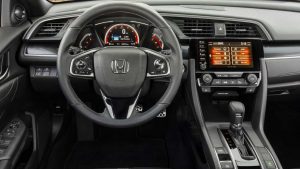
Prices begin at $19,750 for the LX sedan – with a 2.0 liter four cylinder engine, no turbo and a six-speed manual transmission. You can swap the manual for a CVT automatic; so equipped, the LX sedan’s price is $20,550.
Or swap the engine out.
EX trims come standard with a smaller but stronger 1.5 liter turbocharged engine – $23,700 with the CVT. If you’d like that engine with a manual, there’s the Si trim – which also gets a more powerful version of the 1.5 liter engine.
Or split the difference – with the Sport trim. It comes with the Si’s more aggressive 18-inch wheel/tire package, plus suspension upgrades – including a larger-diameter front stabilizer bar – but with the not-turbocharged 2.0 liter engine and your pick of the manual or CVT automatic transmission.
Base price with the six-speed is $21,450; with the CVT it’s $22,250.
The five-door hatchback starts $21,650 with the CVT – all come standard with the turbo’d 1.5 liter engine but you can go with the manual transmission, if you prefer. The Si version with the uprated 1.5 liter engine isn’t offered with the five-door. But you can get a Type-R version that comes with an uprated – turbocharged – high-performance version of the 2.0 liter engine exclusive to this model and only with a six-speed manual transmission.
This one stickers for $36,995.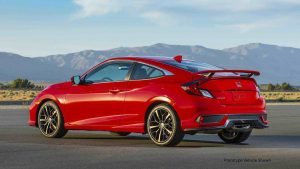
Or stick with the coupe – which comes in base LX, Sport, Touring and Si trims – with either the not-turbocharged 2.0 engine that’s standard in the sedan or the optional 1.5 liter engine that’s optional in the sedan and standard in the hatch, either one available with the CVT or the six-speed manual transmissions.
However you end up going, one-size-fits-all isn’t optional.
What’s New
Five-door Civics and all Si trims get restyled front and rear clips; sedans and coupes come standard with a digital gauge cluster and secondary controls for the audio system mounted on the steering wheel.
Touring trims come standard with heated rear seats.
Mix and match bodystyles, engines and transmissions.
Exceptionally well-thought-out interior design, including cavernous center console storage cubby with configurable shelving that can take a 2 liter soda bottle, an extension cord for USB hook-up (so you don’t have to root around for it) and upward-canted controls (so you can see what you’re controlling).
Sensible standard features include steel 16-inch wheels that are much more resistant to damage from curb strikes and potholes (but you can choose 17 and 18-inch aluminum wheels, if you like).
Extremely peremptory auto-locking system (this can be turned off).
All Civics come standard with “driver assists” such as Lane Keep Assist and Brake Assist that some drivers may not want.
Optional automatic is a CVT automatic.
Under The Hood
The Civic sedan’s standard 2.0 liter, 158 horsepower engine is a conservative engine. It’s the engine for buyers who are leery about the long-term durability of a turbocharged engine – or just don’t want to pay extra for it.
Because it can be paired with a manual transmission it’s a peppy engine in the relatively light (2,762 lb.) Civic, which gets to 60 in about 7.5 seconds so equipped.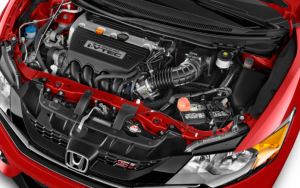
The next-up 1.5 liter engine makes either 174 horsepower or 205 horsepower (in the Si) and once again, Honda gives you the option to go manual – or automatic. This one – in either form – is probably the best one to pick if you prefer an automatic because of the turbo’d engine’s superior low-RPM torque (and so, less need to rev the engine to get a reaction).
The 174 hp version makes 162 ft.-lbs. of torque at just 1,700 RPM; the stronger 205 hp version makes 192 ft.-lbs. a little higher up (2,100 RPM). But both make much more torque – much sooner – than the 2.0 liter’s 138 ft.-lbs. at 4,200 RPM.
Gas mileage is excellent with either engine – ranging from 25 city, 36 with the 2.0 liter engine and six-speed manual to 32 city, 42 highway with the 1.5 liter engine and CVT automatic.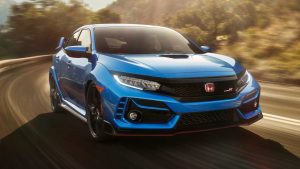
The five-door Civic Type-R’s MPGs – 22 city, 28 highway – aren’t as high, but its performance is extremely high. This one comes standard with a 306 horsepower 2.0 liter turbo’d engine and a close-ratio six-speed manual transmission.
It is capable of 170 MPH.
It’s also one of the most powerful front-wheel-drive cars you can buy.
The Civic has always been one of the sportier choices in the segment, and not just because it is available with a manual transmission and a variety of engines. The ride is firmer and the steering sharper than most – both of which appeal to people who like to drive, as contrasted with those who just need to drive.
The other appeal, of course, is being able to shift for yourself. It is getting hard to find a third pedal in any new car – even entry-level, affordable cars. Which used to habitually come standard with manuals because they cost less and made driving what would otherwise be a boring transportation appliance more fun. They made it possible to work an otherwise lazy engine and – if you knew what you were doing with that third pedal – to get better gas mileage out of the engine.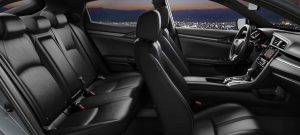
While it’s true that modern automatics (especially CVTs; more on that below) score better on mileage tests, they do so because they are programmed to the test. They upshift into the highest possible gear as soon as possible, in order to cut engine revs and so, increase MPGs.
The problem with that is that it sucks – not gas, but performance. The car doesn’t move. So you push down harder on the pedal, to get it to. And then it does. But gas mileage – wait for it! – goes down when you do.
With a manual, you can keep the engine from lugging and – if you know when to shift – can wring better real-word mileage out of it by timing shifts to anticipate conditions – something not even the most “intelligent” automatic is capable of doing.
Besides which, it is just a lot more fun – especially in a car like the Civic, which has one of the bar-non best shift action you’ll find in any car. Short, precise mechanical syncopation that makes driving even the standard sedan with the base 2.0 engine much more . . . fun than driving an automatic-only car with a larger, stronger engine. There is something for you to do here; at least, something more for you to do than push on a pedal and let the car drive.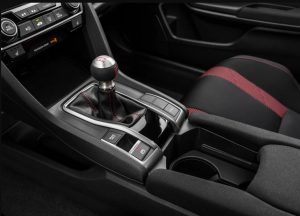
The 1.5 engine is even more fun, with the abundance of torque making it feasible to do things in send or third gear that other cars have to be downshifted to do. The little engine makes good sounds, too – this being deliberately in keeping with Sochiro Honda’s dictum that technology is only good if it makes people feel good.
Something else will make you feel good, too.
Honda absolutely excels at ying-yang balancing responsive and comfortable ride. The Sport and Si trims are track-day-ready cars that are no less civilized everyday cars than the standard sedan/five-door hatchbacks. Even with the much larger (and much shorter sidewall) 18-inch wheels/tires that come standard with the Sport and Si Civics, you will be struck by how similarly they react to not-so-great roads, bumps and so on.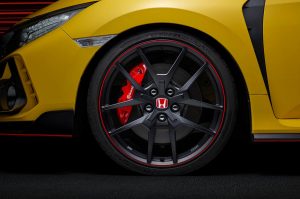
The only tangible difference is the superior capacity of the base sedan – shod with 16-inch steel wheels – to withstand damage to its wheels from potholes and curb strikes. This is the biggest advantage of steel wheels vs. aluminum, which is light (and so good for fuel economy)but also comparatively fragile and more easily damaged.
Which will cost you more money than whatever you saved on gas via less weight if they do get damaged. Which – given the often-terrible state of roads in this country – isn’t an improbability.
Many in this class have roomy back seats, or generous cargo capacity or some other useful attribute. The Civic offers these in more ways – with other things.
The sedan has very roomy back seats (37.4 inches of legroom) but if you need more cargo room, the five-door offers 46.2 cubic feet of that. And if you don’t need either – including the extra doors – there’s the coupe.
And you can get whichever engine you prefer without having to accept the bodystyle you don’t.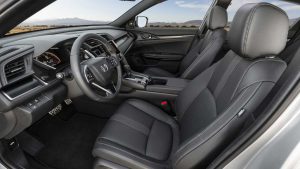
Regardless of bodystyles, you will be astonished by how much center console room the Civic has. And how versatile – configurable – this space is. Slide the armrest back and see how deep it goes. How deep? Deep enough to take a two liter bottle up to the twist cap, just about – and still leave enough room behind it for a full-size bag of chips.
Or, install the sliding twin cupholders – and position them to suit. There is also a sliding package tray; both can be slid independently of one another, too.
And here’s one more thing.
Almost every new car has USB ports for plugging in phones and iPods and such. Many of these cars have hard-to-see USB ports that are buried deep inside the center console or far forward of the center console, which makes them awkward to plug into.
The Civic has a USB extension cord. This simple – brilliant – expedient makes it easy to plug in, which is the best sort of “safety” feature there is.
Speaking of that. The sedan has the best rearward visibility due to the more conventional slope of its rear glass but – that aside – the Civic (all models) is easy to see out of – so you can see what’s coming.
This is also an important safety feature.
The Rest
All trims come pretty loaded – power windows/locks being a given – climate control AC and adaptive cruise control being surprising. As standard equipment. Sport trims get an eight speaker audio upgrade, plus leather trim and a larger (7 inch vs,. 5 inch) touchscreen. You can get 10 or 12 speaker audio upgrades.
The Si gets you upgraded brakes, heavy-duty shocks, a limited-slip diff and a performance gauge cluster, plus Si-specific trim inside and out.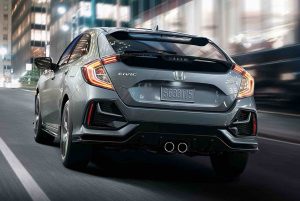
One of the few things you can’t get in a new Civic is a conventional automatic transmission – with gears rather than ranges.
While Honda’s continuously variable (CVT) automatic is one of the best on the market, being quiet and reliable, some people still prefer the feel of a transmission that shifts from gear to gear.
The Bottom Line
Perfection is a never-attainable goal. But the Civic comes awfully close!
. . .
Got a question about cars, Libertarian politics – or anything else? Click on the “ask Eric” link and send ’em in!
If you like what you’ve found here please consider supporting EPautos.
We depend on you to keep the wheels turning!
Our donate button is here.
If you prefer not to use PayPal, our mailing address is:
EPautos
721 Hummingbird Lane SE
Copper Hill, VA 24079
PS: Get an EPautos magnet or sticker or coaster in return for a $20 or more one-time donation or a $10 or more monthly recurring donation. (Please be sure to tell us you want a magnet or sticker or coaster – and also, provide an address, so we know where to mail the thing!)
If you’d like an ear tag – custom made! – just ask and it will be delivered.
My latest eBook is also available for your favorite price – free! Click here. If that fails, email me at EPeters952@yahoo.com and I will send you a copy directly!


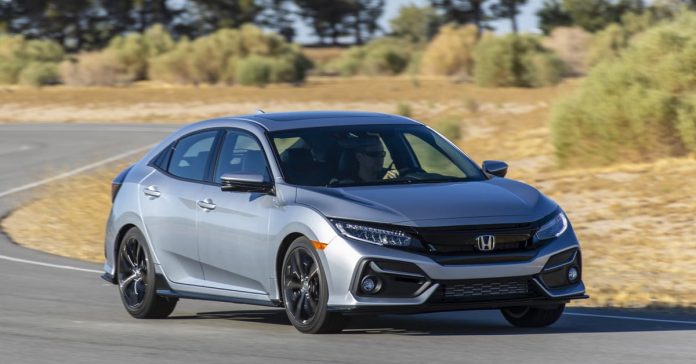

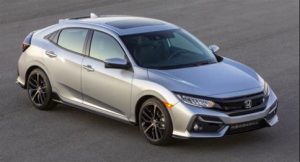

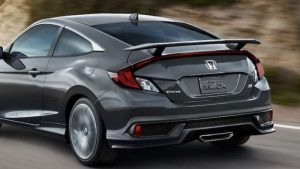









I’m not on board with thinking that a styrofoam cooler sized console eating up space is a good thing. How much crap do you have to have with you every time you go out? Especially if the manual is what you want and getting back to basics with driving.
Barring the rest, besides the tail lights, which are great, I’d have a hard time contracting for 4-5 years of payments on such an eye sore.
I keep thinking back on how trim and neat and clean the 84 Civic was. This is almost as bad as a Juke.
As much as young Mark would like the turbo type R —- older Mark would probably be just fine with the non-turbo 16 inch steel wheels version. i’ll still take the manual though.
Too bad about the CVT….and the garish rear spoiler. Otherwise, as close to perfect as you can get in this segment.
To be effective, do spoilers really have to be as ugly as those on the Civic?
Hi Mike,
I’m with you on the spoiler, which – unlike the whale tail on my Trans-Am – looks tacky because it looks tacked on. I have no idea whether the Civic’s provides meaningful downforce on the rear; the Trans-Am’s does – wind tunnel tested for SCCA road racing, even!
I doubt it has much meaningful effect, in part because the Civic – unlike my TA – is a modern car and probably doesn’t need much in the way of downforce on the rear until the car is moving really fast – which is largely an irrelevance on American roads today.
I seem to remember reading the tacky spoiler on the Type R actually does improve performance. Dont quote me on that though lol.
Hi Josh,
It probably does have some effect at high speed; but whether it’s a meaningful effect at most road speeds is another matter. Same may be true of my ’70s Trans-Am’s whale tail; but it at least looks good 🙂
“This one comes standard with a 306 horsepower 2.0 liter turbo’d engine and a close-ratio six-speed manual transmission.
SIGN ME UP!!
If money were no problem, I agree 100%. But at $37K for the R version compared to $19,750 for the no-turbo, a $17,250 difference, I’m able to afford a real hot rod or upgrades galore and have big $ leftover. The real question is can the $19.8K version handle a bolt on turbo or is the engine internals not up to snuff? What say you Eric? Inquiring minds want to know!! Keep up the great work, love your style!
Thanks, Saxon!
My bet is the non-turbo’d 2.0 engine could handle some boost; Honda (and Acura) engines are historically agreeable in that respect. An aftermarket turbo/intercooler kit/exhaust, etc – probably bout $5k all in – would likely get you very close to the Type R’s performance and would also be a lot of fun!
The 2.0T engine in the Accord is a de-tuned version of the Type R engine. You can get this engine in 6MT in the Sport Package for $31k sticker. A simple flash tune for less than $1,000 will get you to nearly the same power as the CTR. You save $5k off sticker (and the $10k “market adjustment” that many dealers are charging for the CTR) and you don’t get the boy racer looks of the CTR. Stealth mode = on.
Hat tip Wally!
Ich danke dir!